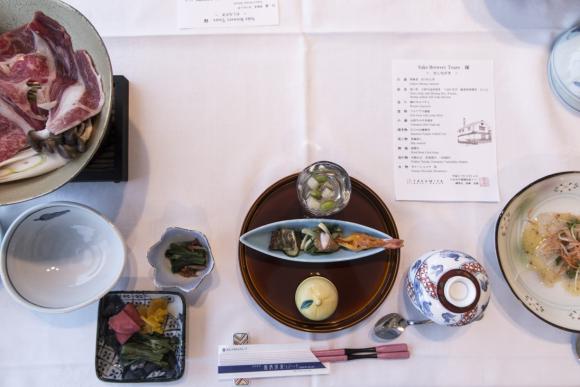Sake from the Frozen North - Day 2, Yonetsuru and The Snow Monsters
POSTED ON 29/03/2015Checking out of our hotel on the dot of at 8.20am (well, this is Japan), we took the one-hour drive to Yonetsuru Brewery in Takahata on a chartered bus. We had to arrive by 9.30 am because that’s when the rice-steaming starts and rice-steaming waits for no-one.
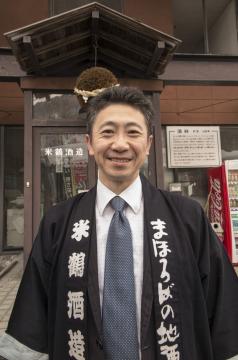 Yoichiro Umetsu at Yonetsuru
Yoichiro Umetsu at Yonetsuru
Along the way, Etsuko, one of only 53 sake samurai in the world, did her girl guide duties telling us that the area is famous for cherries and pears. She recounted the 400-year-old legend of the region’s beloved Uesegi clan, who were shut out of the shogunate for opposing Tokugawa Ieyasu in the Sekighara Campaign, but recovered under Uesegi Tsunanori, who restored Yonezawa to its former prosperity.
A pit stop. Busy yellow snowploughs plied up and down the road shovelling snow. The cold morning sparked an interest in vending machines which deliver hot and cold coffee in cans. I opted for the hot. Etsuko informed us that the sake tours started eight or nine years ago.
“We soon realised that by going to see the sake-making process and drinking sake with local food, how could you not love sake? We wanted people from all over the world to see that sake is a product crafted with intensive labour, intense passion and true craftsmanship. We have so far covered around six or seven destinations. The Tohoku region is special because it’s both snow country in the west and milder on the Pacific Ocean side to the East”.
We picked up at Yonestsuru at the appointed hour to be welcomed by a smiling Yoichiro Umetsu. He explained that although his career path was to become a nuclear scientist, his father asked him to come back and take over the company 12 years ago. Realising at the age of 30 that his future lay in sake, the prodigal son, in a curious echo of the Uesegi clan legend, returned to the brewery in order to maintain and grow the traditions long held by earlier generations.
 Rice steaming
Rice steaming
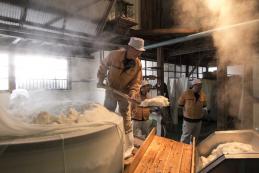 Rice cooling
Rice cooling
“At that time we were using three different types of rice with three different milling rates and each was sold as a different product, so we had no clear target market”, said Yoichiro. “It took us 12 years but now we target a specific audience with each sake. Using contract local growers to grow rice for us in the area of the brewery to make good sake, we aim to try something new and to be innovative.
“So last night when we drank sake together, I showed you our sparkling sake. We also have modern labels like the cats label. And we’ve created a lower alcohol sake (Andante, at 12%) for those who find the alcohol in sake too high”.
Entering the humid rice-steaming room, we watched as steamed sake rice was scooped into the cooling machine. After steaming in large batches of between 750 kilos and a ton, the milled, steamed Haenuki rice tasted warm and nutty, with a hardened exterior and soft internal core.
After cooling, a proportion of the steamed rice was taken to the koji room and spread by hand. The koji mould was sprinkled over it and worked into it by hand to allow its enzymes to convert the rice grain from starch to fermentable sugar. We watched as two men stirred a murky liquid containing the yeast starter, ready for the addition of two further lots of rice on the third and fourth days, and fermentation, which takes 25 – 26 days, in 16 separate tanks.
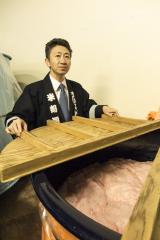 Lifting the lid on pink sake
Lifting the lid on pink sake
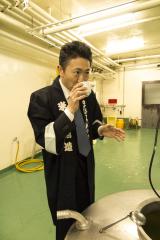 Job done
Job done
It was a fascinating visit because although both Toko and Yonetsuru breweries are in the same region with much in common, we were able to observe how real differences in philosophy and style can influence the style of the sake too. On the previous day we saw at Toko a very traditional brewery specialising in making excellent premium sake. Today we observed how Yonetsuru was led by Yoichiro Umetsu’s mission to innovate.
To that end he showed us a variety of different styles, ranging from his light-in-alcohol Andante to sake made from new kinds of rice, among them the delicious Kissui. We also tasted a spicy unpasteurized junmai daiginjo made from Dewanasoto rice and a smooth junmai daiginjo made from Dewasansan.
And at one point, Yoichiro took the lid off a small vat of rosé sake that was busily bubbling under like pink candy floss. I can’t remember a moment throughout the tour when he wasn’t smiling; not the smug smile of a self-assured control freak, but the smile of a man both humble and respectful of tradition on the one hand and proud of the brewery’s achievements on the other.
As we got on the bus to leave, we waved farewell. With bento box on laps, and a bottle of sake to keep us company, we drove to Zao Onsen, a resort hotel in the mountains which was to be our base for the next two nights. The sun was shining when we arrived at the hotel, the Rurikura Resort, Zao Onsen, and the snow on the ski slopes opposite looked so inviting that four of our party peeled off to ski instead of joining us on our scheduled cable car trip up the mountain to meet the snow monsters.
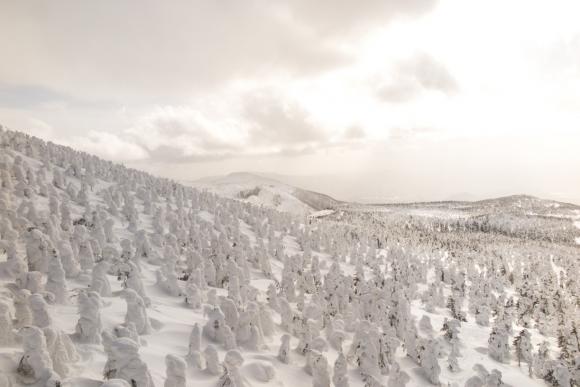 Snow Monsters
Snow Monsters
I was tempted by the Zao Ski Resort’s nursery slopes, despite not having ski-ed for 20 years, but the snow monsters beckoned. It was the right choice as it turned out. It was already 2pm and, risk of broken bones apart, I wouldn’t have got much ski-ing in anyway by the time I’d hired ski boots and skis and bought the necessary tickets.
So up the mountain the rest of us went, suitably clad in warm clothes and snow boots. First we stood in a packed cable car which glided over green fir trees laced with snow and stopped half way up. Then, in more relaxed style, we sat in a second cable car that took us to Jizo Sancho Station between the peaks of Mount Sanpokojin and Mount Jizo.
As we passed the lacey-white frost-shrouded trees on our way to the summit, we reached clumps of firs, which, the higher we went, the more they retained of the heavy snow that had fallen on them, until they were completely buried under snow. These were the snow monsters, a phenomenon seen only in a few areas of Yamagata in January and February.


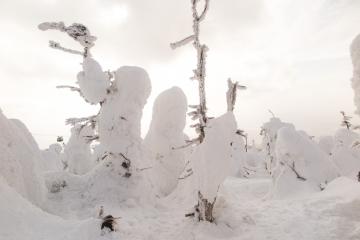

The trees had become so engulfed by snow that they were no longer visible as trees but instead had turned into a ragtag snowman army seemingly stopped in its tracks by some natural disaster. Rounded and sculpted by icy winds into an artistic statuary of a thousand surreal shapes and sizes, they resemble whatever your imagination wants to make of them.
As you walk around them, getting up close and personal, they tower over you, standing upright, leaning or drooping at a variety of angles. They seem to look at you, threaten you or wave a friendly arm or leg. Some have even succumbed to the weight of the snow and fallen to the ground. At -6C even without the wind chill factor, it was so cold that you had to have hat and gloves if you weren’t to be at risk of turning into a snow monster yourself.
Back down the mountain we went for an early dinner. Accompanied by a variety of sakes we had brought with us, we hungrily devoured 10 beautifully presented dishes in the hotel restaurant overlooking the nursery slopes. After three fish-based courses around shrimp and bream, among the highlights were foie fras with lotus root, Yamagata Beef Sukiyaki and Japanese Pepper-Grilled Cod. While the more intrepid in our group returned to re-visit the snow monsters lit up at night, I opted to relax in a satisfyingly stinky but wholly reviving onsen spa bath.
